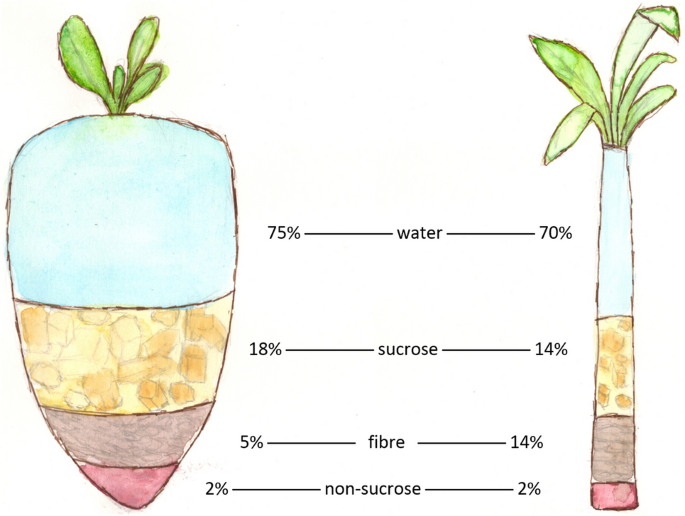How to choose between Sugar beet vs sugar cane for your culinary needs
Comprehending Sugar Beet Vs Sugar Cane: a Deep Study Their Handling and Applications
The comparison between sugar beet and sugar cane exposes vital differences in their handling and usage. Each crop has distinct growing approaches that influence its geographic distribution. Sugar beets are mainly processed into granulated sugar for different food items, while sugar cane is frequently utilized in drinks. Recognizing these differences loses light on their duties in the food industry and their economic relevance. Yet, the broader ramifications of their farming and handling call for more expedition.
Review of Sugar Beet and Sugar Cane
Sugar beet and sugar cane are 2 key sources of sucrose, each contributing considerably to the global sugar supply. Sugar beet is an origin veggie, typically harvested in cooler environments, while sugar cane is a high turf that flourishes in warmer tropical and subtropical regions. The handling of sugar beet includes washing, slicing, and extracting juice, complied with by filtration and condensation. On the other hand, sugar cane handling includes crushing the stalks to remove juice, which is after that clarified and focused right into sugar crystals.
Both crops are rich in sucrose, yet their structure differs a little, with sugar cane usually having a higher sugar content. Each source additionally contributes in biofuel production, with sugar beet typically used for ethanol. While both are essential for different applications, their unique development requirements and handling techniques influence their respective payments to the sugar market.
Geographical Distribution and Farming Problems
Sugar beet and sugar cane are cultivated in distinctive geographical regions, affected by their details climate and soil requirements. Sugar cane prospers in exotic climates, while sugar beet is better matched for temperate areas with cooler temperature levels. Comprehending these farming conditions is important for maximizing production and guaranteeing top quality in both crops.
Worldwide Expanding Regions
While both sugar beet and sugar cane are necessary resources of sugar, their worldwide expanding areas differ substantially due to environment and soil demands. Sugar beet grows mainly in warm areas, with substantial production focused in Europe, North America, and components of Asia. These areas commonly feature well-drained, fertile dirts that sustain the plant's growth cycle. On the other hand, sugar cane is greatly grown in exotic and subtropical regions, with significant manufacturing hubs located in Brazil, India, China, and Thailand. This crop flourishes in warm, damp settings that promote its growth. The geographical distribution of these two crops highlights the versatility of sugar cane to warmer climates, while sugar beet stays dependent on cooler, pleasant problems for peak development.
Climate Requirements
The climate needs for sugar beet and sugar cane vary significantly, reflecting their adjustment to distinctive ecological conditions. Sugar beet grows in pleasant environments, calling for awesome to moderate temperatures, preferably ranging from 15 ° C to 20 ° C. It is delicate to frost and gain from well-distributed rainfall during its expanding period. This plant is usually grown in regions such as Europe and North America.
On the other hand, sugar cane flourishes in tropical and subtropical climates, favoring warmer temperatures between 20 ° C and 30 ° C - Sugar beet vs sugar cane. It calls for plentiful sunshine and regular rainfall, making it well-suited to areas like Brazil, India, and Southeast Asia. The contrasting environment choices of these plants noticeably affect their geographical distribution and agricultural techniques
Dirt Preferences
Both sugar beet and sugar cane need details dirt conditions to grow, their choices differ substantially. Sugar beets thrive in well-drained, fertile soils rich in organic matter, with a pH ranging from 6.0 to 7.5. These problems are commonly found in pleasant regions, particularly in Europe and The United States And Canada. In comparison, sugar cane chooses deep, productive soils with superb drainage and a slightly acidic to neutral pH (6.0 to 7.0) This plant is mainly cultivated in tropical and subtropical environments, such as Brazil, India, and Australia. The geographical distribution of these plants mirrors their dirt choices, as sugar beets are matched for cooler climates, while sugar cane thrives in warmer, extra damp settings.
Collecting and Handling Techniques
In analyzing the harvesting and processing strategies for sugar beet and sugar cane, distinctive methods emerge for every plant. The comparison of harvesting approaches exposes variations in effectiveness and labor requirements, while removal strategies highlight differences in the first handling stages. Additionally, recognizing the refining processes is necessary for reviewing the quality and yield of sugar generated from these 2 sources.
Gathering Methods Comparison
When thinking about the collecting methods for sugar beet and sugar cane, distinct strategies emerge that reflect the unique qualities of each crop. Sugar beet harvesting normally entails mechanical methods, using specialized harvesters that uproot the beets from the ground, getting rid of tops and soil while doing so. This technique permits for efficient collection and lessens plant damages. In comparison, sugar cane harvesting can be either manual or mechanical. Manual harvesting involves workers reducing the stalks short, while mechanical harvesting utilizes large makers that reduced, slice, and gather the cane in one procedure. These differences in harvesting methods highlight the flexibility of each crop to its growing atmosphere and the agricultural methods prevalent in their particular regions.
Removal Strategies Overview
Removal methods for sugar manufacturing differ significantly in between sugar beet and sugar cane, reflecting their special characteristics and handling demands. Sugar beets are usually harvested using mechanical farmers that reduced the roots from the ground, adhered to by washing to eliminate dirt. The beetroots are then cut right into slices, called cossettes, to help with the removal of sugar via diffusion or warm water extraction. On the other hand, sugar cane is generally gathered by hand or maker, with the stalks cut close to the ground. After collecting, sugar cane undertakes squashing to draw out juice, which is then clarified and focused. These extraction methods highlight the distinctive techniques used based on the source plant's physical qualities and the preferred efficiency of sugar removal.
Refining Procedures Discussed
Refining procedures for sugar from both sugar beet and sugar cane entail several necessary steps that ensure the final product is pure and ideal for consumption. Initially, the raw juice drawn out from either resource goes through clarification, where pollutants are gotten rid of using lime and warmth. Following this, the juice is vaporized to concentrate the sugars. For sugar beetroots, the procedure usually consists of carbonatation, while sugar cane might undertake a much more uncomplicated condensation approach. When focused, the syrup is subjected to condensation, generating raw sugar. Ultimately, the raw sugar is purified via centrifugation and more refining, leading to the white granulated sugar generally found on store shelves. Each action is crucial in making sure item top quality and safety and security for customers.
Nutritional Profiles and Health Impacts

Health impacts related to both sources mostly stem from their high sugar content. Too much intake of sucrose from either resource can result in weight gain, dental problems, and boosted risk of persistent diseases such as diabetic issues and heart problem. Nonetheless, sugar cane juice, often consumed in its all-natural form, might supply added anti-oxidants and phytonutrients compared to refined sugar beet products. Eventually, moderation is essential in utilizing both sugar beet and sugar cane in diet regimens to alleviate possible health risks.
Economic Significance and International Production
The financial value of sugar beet and sugar cane is significant, given that both crops play important roles in the worldwide agricultural landscape. Sugar cane, mostly grown in check this site out tropical and subtropical regions, make up roughly 75% of the globe's sugar production. Nations like Brazil and India are leading producers, adding substantially to their nationwide economic climates with exports and local usage.

The worldwide sugar market is valued at billions of bucks, affected by various aspects consisting of climate, trade policies, and customer need. Appropriately, both sugar beet and sugar cane are crucial for economic stability and development within the farming field worldwide.
Applications in the Food Market
In the food sector, sugar beet and sugar cane serve essential functions, providing sweeteners that are indispensable to a broad selection of products. Both resources produce granulated sugar, which is a main active ingredient in baked products, drinks, and confections. Sugar beet, frequently liked in areas with colder environments, is frequently located in refined foods such as jams, jellies, and milk special info items. On the other hand, sugar cane is preferred in tropical areas and is frequently utilized in beverages like rum and soft beverages.
Beyond granulated sugar, both sources are likewise processed into molasses, syrups, and other sweeteners, enhancing flavor accounts and boosting appearance in different applications. Furthermore, the by-products of sugar production, such as pulp and bagasse, are used in producing animal feed and biofuels, even more demonstrating their flexibility. In general, sugar beet and sugar cane are important elements of the food sector, affecting preference, structure, and general item top quality.
Ecological Considerations and Sustainability
As concerns about climate change and source exhaustion grow, the environmental influence of sugar beet and sugar cane farming has come under scrutiny. Sugar cane, typically grown in exotic regions, can result in logging and environment loss, exacerbating biodiversity decrease. Furthermore, its cultivation regularly depends on intensive water usage and chemical plant foods, which can pollute local rivers.
Alternatively, sugar beet is typically expanded in pleasant climates and might promote dirt health and wellness through plant rotation. Nonetheless, it also encounters difficulties such as high water usage and dependence on chemicals.
Both crops add to greenhouse gas emissions during handling, but sustainable farming methods are arising in both industries. These consist of accuracy farming, chemical-free farming, and integrated bug management. On the whole, the environmental sustainability of sugar manufacturing continues to be a pressing problem, demanding continual assessment and adoption of green practices to reduce negative impacts on ecosystems and areas.

Regularly Asked Inquiries
What Are the Differences in Taste Between Sugar Beet and Sugar Cane?
The taste differences between sugar beet and sugar cane are subtle yet distinct. Sugar beet has a tendency to have a somewhat earthier taste, while sugar cane offers a sweeter, a lot more fragrant profile, attracting numerous culinary preferences.
Can Sugar Beet and Sugar Cane Be Used Interchangeably in Recipes?
Sugar beet and sugar cane can typically be utilized interchangeably in dishes, though refined differences in flavor and texture might arise. Replacing one for the various other usually keeps the desired sweet taste you can try these out in cooking applications.

What By-Products Are Developed From Sugar Beet and Sugar Cane Processing?
The processing of sugar beets and sugar cane yields various byproducts. These consist of molasses, pet feed, and biofuels. Each byproduct serves unique objectives, contributing to farming and industrial applications past the primary sugar extraction.
Exactly How Do Sugar Beet and Sugar Cane Affect Dirt Wellness?
The influence of sugar beet and sugar cane on dirt wellness differs; sugar beets can boost organic matter, while sugar cane might result in dirt deterioration if not managed properly, influencing nutrient degrees and soil structure.
Are There Specific Selections of Sugar Beet and Sugar Cane?
Numerous details ranges of sugar beet and sugar cane exist, each adapted to different environments and dirt kinds. These ranges are cultivated for traits such as return, condition resistance, and sugar material, optimizing farming performance.